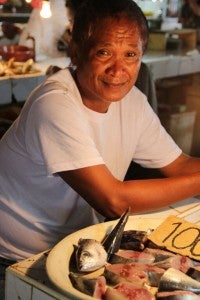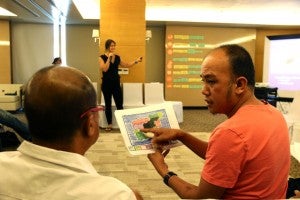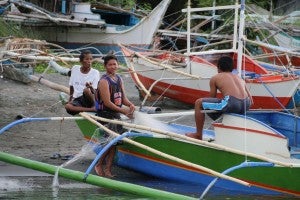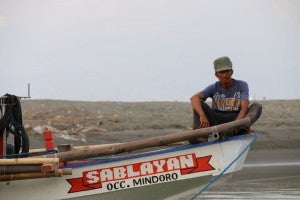
Photo: Kaia Joye Moyer
By: Kaia Joye Moyer, Masters Student at UC Santa Barbara’s Bren School of Environmental Science and Management
It is 5am. The sun is just rising, but Hermes Arandas, a fisher from Totolan, Dauis, Bohol in the Philippines, is anything but just waking up. Today he and six fellow fishers are pulling their banca, a long slender outrigger canoe into the boat landing area. The men left the harbor at 4 pm the previous day and have been out fishing all night. Hermes tells me that he remembers fishing with his father. Back then, the fish were not far from shore, but today they can’t be found there. In order to continue to support his family, Hermes must fish farther and longer because catch is decreasing and fish are getting smaller.
Unfortunately Hermes is not alone in his story. More than 90% of the fishermen around the world are small-scale fishers like Hermes, mostly living in developing nations. And while these fishers provide half of the global fish catch, they are also particularly vulnerable to overfishing because they rely on fish for both their livelihood and food source
It is stories like Hermes’ that brought us to the Philippines.
We are a group of master’s students—Jennifer Macy, Kaia Joye Moyer, Rodrigo Oyanedel, Salvador Rodriguez, and Keith Shattenkirk—from UC Santa Barbara’s Bren School of Environmental Science and Management. For the last 13 months we have been working on a project with EDF to develop a tool to assist in small-scale fisheries management to help improve the sustainability of fisheries for fishers like Hermes and others we met on a recent trip to the Philippines.

Photo: Kaia Joye Moyer
One increasingly proposed solution to stop overfishing in these areas is Territorial Use Rights for Fishing (TURFs) paired with no-take zones (Reserves). These combined TURF-Reserves provide fishers with exclusive long-term access to defined fishing areas while protecting critical areas from fishing pressures, allowing fishers to directly benefit from exclusive fishing rights and spillover from reserves. EDF, Rare, and the Sustainable Fisheries Group at the University of California, Santa Barbara have combined their expertise in fisheries science, rights-based management, and community mobilization to form the Fish Forever partnership, an initiative to restore small-scale, coastal fisheries through the implementation of TURF-Reserves.

Photo: Kaia Joye Moyer
Designing a site-appropriate TURF-Reserve can be challenging, as you have to take into account the biological characteristics of the species, spatial variation, economic conditions, and social limitations. To help meet this challenge, we developed “TURFtools,” an excel-based tool that uses the best available science, as well as local fishers’ knowledge, to inform communities about the tradeoffs between different spatial TURF-Reserve designs.
Working in the confines of Santa Barbara however, there was a driving need to field test and ground truth our tool. To ask questions. To test it. Was the tool applicable and accessible? Was it appropriate for use internationally? How could local data collection processes be integrated into the TURFtools model? Were there components that were unclear?
With the support of EDF and the Bren school, our team traveled to Cebu City in the Philippines. Over the course of our visit, we were able to run hands-on demonstrations with the Fish Forever team and incorporate feedback into our final product. We learned the importance of communication, the need for quantitative analysis for site managers, and the most effective means for presenting visual data in a way that considers the cultural context.

Photo: Kaia Joye Moyer
Our last phase of testing was with Fish Forever’s field partners, called fellows, who come from the communities where Fish Forever is at work. Over the next three years these 24 fellows will work in and with their communities to design TURF-Reserves, using the TURF-Reserve design tool we created to inform the decision-making process. We presented the tool to build familiarity, demonstrate how it worked, and dispel any fears or confusion about using the tool itself. We received valuable positive feedback at the end of the day (and numerous photo ops).
As of this May, our Bren team has turned over the TURF-Reserve design tool to its new home with the EDF Ocean’s team. Its first stop will be the Philippines, where it is being tested and integrated into the TURF-Reserve design process, aiming to improve fisheries like that of Hermes Aranas. Fish Forever will make country-specific customizations to the tool for use in other countries. We are hopeful that this tool will support fishing communities as they design TURF-Reserves to meet their community goals, so that they can ensure sustainable and profitable fisheries long into the future.









